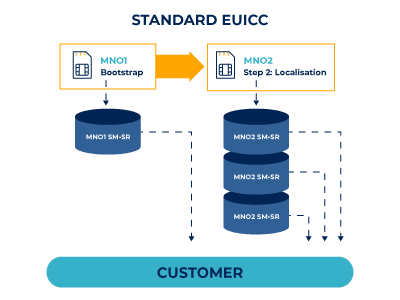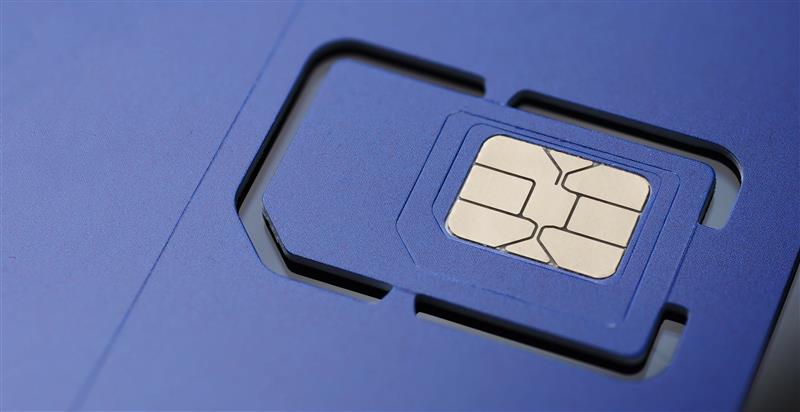Quick Summary
eUICC (Embedded Universal Integrated Circuit Card) technology allows remote management of SIM profiles. This flexibility supports seamless network switching and simplifies the logistics of IoT device deployment.
What is eUICC?
eUICC stands for embedded universal integrated circuit card (eUICC). It refers to the software component of eSIM that runs on a UICC and provides the capability to store multiple network profiles that can be provisioned and managed over-the-air (OTA). The term eUICC is often used to mean the whole physical card or chip.
Why eUICC exists
To solve the historically painful process for mobile phone customers changing network suppliers, the GSMA introduced the eUICC specification to enable users to change their network provider without physically swapping the SIM card.
Although it was envisaged that eUICC SIMs would primarily be in the form of soldered chips or implemented within a system on a chip (SOC), eUICC SIMs can be any SIM form factor.
The GSMA eSIM standard
One of the major barriers to successful IoT deployments is the difficulty in switching devices to different mobile networks once the devices are in the field. With changes in legislation around data sovereignty and updates to IoT roaming agreements, permanent roaming isn’t a feasible option in many situations. With roaming IoT devices at risk of losing connectivity, it’s increasingly important that devices can be switched to local networks when required. If devices have embedded SIMs or are in remote locations, it’s critical that network switching instructions can be sent OTA.

Consumers will also suffer a painful process when they want to change network suppliers for their mobile devices. Historically, incoming suppliers have had to provide new SIM cards and require that consumers physically change the SIMs in their devices.
To solve these challenges, the GSMA introduced eSIM – embedded SIM Remote Provisioning Architecture. eSIM technology provides the same functionality and security as conventional SIMs, with enhancements that enable:
- Secure, over-the-air updates for remote provisioning and management of profiles using Remote SIM Provisioning (RSP) systems
- Storage of multiple network profiles on eUICC SIMs
eSIM has two versions, one for consumer devices and one for Machine-to-Machine (M2M) devices.
The difference between eSIM and eUICC
eUICC is one component of eSIM – the software that runs on a SIM to enable remote provisioning and management of network profiles.
The GSMA envisaged that eUICC SIMs would primarily be in the form of soldered chips (such as the MFF2) or implemented within a system on a chip (SOC). For this reason, they used the term embedded SIM (eSIM) for the remote SIM provisioning architecture. However, eUICC SIMs can be any SIM form factor, removable or non-removable.
The terminology can lead to confusion as the term eSIM is sometimes used to mean an embedded SIM (such as the MFF2), whether or not it is an eUICC SIM. When the term eSIM is used, it’s important to be clear whether this refers to the full GSMA eSIM architecture and solutions, an eUICC SIM, or simply a non-removable SIM.
eUICC profiles
A profile for an eUICC SIM contains the operator subscription data, including the authentication credentials, as well as SIM-based software and applications. The content and structure of profiles is standardised to ensure that all parties in the eSIM ecosystem can operate together.
eUICC SIMs can hold multiple profiles, with each profile acting as a virtual SIM within the physical SIM container. Only one profile can be enabled (active) at any time.
The main types of profile are:
- Bootstrap profile
A bootstrap profile (also known as a provisioning profile) enables a device–at a minimum–to access a cellular network in order to communicate with an RSP system when it first starts up. The RSP system can then download and activate an operational profile for the device to use. Most providers supply a bootstrap profile that has full access to an operator’s network and roaming agreements. This enables the device to start operating as soon as it starts up. - Operational profile
An operational profile (also known as a step 2 profile) provides a device with full access to an operator’s network. Downloading and enabling a new operational profile means a device can switch to a different network without the need to physically change the SIM.
The number of profiles that can be stored on an eUICC is limited only by the memory available in the SIM and the size of each operator’s profile.
When to use eUICC for IoT
The SIMs in IoT devices have a critical job in ensuring secure, reliable network connections. They are the key to zero-touch connectivity that starts when devices are installed and continues throughout their life.
Knowing whether to use eUICC SIMs in an IoT deployment depends on your connectivity provider’s eSIM capability and your future requirements.
In this section:
- Connectivity from a Mobile Network Operator (MNO)
- Using a managed IoT connectivity provider
- eSIM implementation challenges
Connectivity from a single MNO
In some cases, a single Mobile Network Operator (MNO) may be able to provide the connectivity for an IoT deployment. This is only viable if the MNO provides sufficient local and roaming coverage for the devices and offers a SIM that meets IoT requirements such as durability and OTA updating.
Enterprises must consider whether they might want to switch devices to a different network during the lifetime of the devices – for example, to change supplier at the end of a contract or in response to changing commercial or service requirements.
If remote switching is required, the MNO must provide eUICC SIMs and have the eSIM infrastructure in place to transfer the devices to another supplier. As discussed later, this is not always straightforward.
Using a managed IoT connectivity provider
For most IoT deployments, a single MNO doesn’t provide the flexibility to handle global installations and single SKU products, mobile devices, gaps in coverage, roaming restrictions, and changes in the commercial and service landscape in mobile telecommunications.
Managed connectivity solutions with multi-IMSI SIMs can address these requirements. Traditional SIMs contain a single International Mobile Subscriber Identifier (IMSI) from an MNO that is tied to the operator’s network. Multi-IMSI SIMs store multiple IMSIs, enabling devices to switch to different networks without physically changing the SIM.
Although multi-IMSI solutions offer remote switching without requiring eUICC SIMs, the eSIM solution can offer additional benefits:
- Some multi-IMSI solutions don’t provide sophisticated switching or the ability to download additional IMSIs OTA for localisation. eSIM can enhance these solutions to provide more flexible, resilient connectivity for IoT.
- Some network operators don’t provide IMSIs to third parties for security reasons but will supply eSIM network profiles to their partners, giving these providers more connectivity options.
- Unlike eSIM, multi-IMSI operation is not governed by a global standard or certification system. Using eSIM ensures that different parties can operate together seamlessly and securely.
Connectivity solutions that use both multi-IMSI and eUICC-enabled SIMs are the most future-proofed solution for IoT deployments.
eSIM implementation challenges
Using eUICC SIMs for your IoT deployment may seem an obvious decision. But it’s not always straightforward.
The consumer eSIM standard works well. Consumer devices have a user to operate the switching process, which means that complex integrations between operators’ systems are not required. Users can use Wi-Fi rather than cellular to connect devices initially, which simplifies the switching process.
The M2M version of eSIM is more challenging. For example:
- Network operators must run their own RSP systems and implement costly and complex integrations with other operators’ systems to enable network switching. With over 800 network operators, it’s unlikely that every operator will have integrations with every other operator – certainly not any time soon.
- Some providers who claim to support eSIM actually offer an eUICC-compliant SIM but do not have the off-card infrastructure to enable remote switching. Enterprises may find they have a limited choice of networks they can switch to once their devices are live–and may find they can’t switch at all if their provider isn’t fully compliant with eSIM.
- Even when a switch is successful, a device may fail to connect to the new network for some reason. If the previous profile is no longer accessible, the device may not be able to connect at all. Without remote management capability, the only solution is to physically visit the device to resolve the issue.
- Enterprises that do manage to switch their devices to different operators can end up with multiple contracts and admin management, as well as multiple support and billing systems to navigate.
- Downloading profiles to battery-operated IoT devices can be a challenge. A device may be programmed to connect for a very short period to conserve battery life. Each short connection may not be long enough for the profile download to complete.
The future of eUICC
Despite the challenges for IoT, eSIM provides the foundation for improving the success of IoT deployments.
The key to reaping eSIM benefits lies in finding a connectivity provider who can:
- Offer multi-IMSI, eUICC SIMs for the greatest flexibility, resilience, and choice of networks
- Operate their own RSP infrastructure and systems for maximum control
- Provide a single contract, support system, and invoicing for IoT deployments, regardless of which networks the devices connect to or switch to during the deployment lifetime
- Understand and resolve connectivity challenges, such as downloading profiles to battery-operated devices
Get IoT connectivity you can trust
Award-winning eUICC eSIM connectivity delivering simple, secure and intelligent global cellular connectivity for your devices.
Paul is one of Eseye’s co-founders. With a background in senior design engineering, Paul’s focus is on ensuring his development, operations and support teams deliver solutions that work faultlessly in the field.
Paul was co-founder of CompXs, with Ian Marsden, and developed the world’s first IEEE 802.15.4 radio. Before CompXs, Paul was in senior radio design at Philips.

